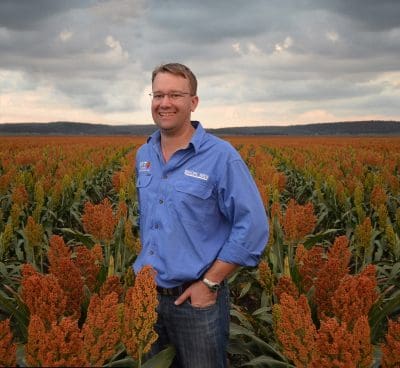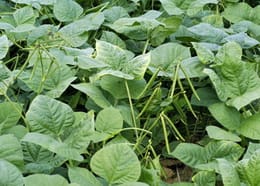DRYLAND cotton, mung beans and irrigated rice are shaping as the big winners in this season’s summer cropping lottery as growers throughout Queensland and NSW begin summer plantings.
The heightened interest in cotton and mung beans is at the expense of sorghum which, while set to remain a key summer crop, is likely to be down in area this season on the back of low prices.

Advanta Seeds sorghum business manager, Andrew Short, says the area sown to sorghum is expected to be significantly down this summer.
Sorghum is currently priced at just over $200/tonne track Newcastle, well below the peak last year of $339/t.
Despite the Australian Bureau of Agricultural and Resource Economics and Sciences’ (ABARES) prediction that the total area planted to summer crops will rise by 21 per cent in 2016-17 to around 1.4 million hectares, the Bureau says the area planted to grain sorghum is set to fall by 7pc to 631,000 hectares.
Big year for cotton
ABARES predicts cotton will have a stellar year with the area planted to the fibre crop forecast to rise from 270,000ha last season to 475,000ha.
Rice is another big prospect this summer with the Bureau predicting the area planted to rice will increase four-fold on last year to 90,000 hectares, reflecting a substantial rise in the supply of irrigation water to the rice-producing irrigation districts of the Murray and Murrumbidgee valleys.
Advanta Seeds sorghum business manager, Andrew Short, Toowoomba, said the summer cropping season was looking promising for dryland producers with high subsoil moisture levels through most districts.
However, the season had got off to a slow start with cool, wet weather meaning opportunities for sowing were going to be later than normal.
Sorghum area down
Mr Short said sorghum plantings were expected to be significantly down this year compared to the past couple of years when prices of around $300/t and unprecedented demand from Chinese liquor producers saw Australia grow around 680,000 hectares of sorghum last year.
“We are expecting sorghum in general to be back because of the large winter crop that has taken a lot of country out of the equation, plus the sorghum price has come off where it has been for the last couple of years,” he said.
“The rotational benefits of sorghum will still make it attractive to some people. It will still be a major summer crop.”
Mr Short said while the main area for sorghum production was between Central Queensland and the Liverpool Plains of northern NSW, some growers were trialling it further south into southern NSW.
“People who have traditionally been winter crop are looking for summer alternatives for weed control. That is an area where we are seeing an emerging market for seed sales,” he said.
Surge in corn plantings
Mr Short said the early rains had prompted a surge in plantings of early maize.
“Interest in corn has been fantastic. The prices for corn aren’t fantastic but are okay. The fall of the sorghum price has helped, plus we had good early rain. You traditionally plant corn earlier than sorghum, so some has gone in already,” he said.
Likewise, there had been an increase in seed sales of forage sorghum for stock feed.
“High cattle prices have seen an increase in interest in forage sorghum. The high prices are encouraging people to put in supplementary feed,” he said.
In Central Queensland (CQ), Landmark branch manager at Clermont, Anthony Lee, agreed that sorghum plantings would be significantly down on last year.
He said with prices for sorghum so low it was hard to make a return from them, especially with the cost of managing nitrogen and herbicide inputs compared to some of the pulse crops that were currently making good money.
“When prices are where they are for chickpeas and mung beans you can go at them with fungicides and insecticides and get a good return. Whereas with sorghum at the moment, it is very difficult to make money out of them,” he said.
Mung beans come of age
Mr Lee said CQ growers were likely to plant as many, or even more, mung beans this season than they did last year, which was a particularly big year for the opportunity, short season crop in the region.
“I think mung bean plantings will stay where they were last year, if not a little bit of upside.”
Australian Oilseeds Federation executive director, Nick Goddard, said there was a lot of interest in mung beans throughout Queensland and northern NSW.
“The price is still high after the Indian drought and it is taking a while to refill the supply chain. There is good demand for Australian mung beans. The mung bean industry has come of age in the past couple of years,” he said.
Mr Goddard said soybeans would again be an important crop on the NSW north coast and Queensland’s Darling Downs, with the Riverina in southern NSW likely to come back on stream this year after little production last season due to the price of irrigation water being too high.
He said the depressed price for sunflowers was holding some growers back from growing the crop this season, but it would still be grown by those who saw the crop playing a useful role in their summer rotation.
Get our free daily cropping news straight to your inbox – Click here
On the Darling Downs, Landmark agronomist, Hugh Reardon-Smith, said cotton was likely to be widely grown on the tail of reasonable prices.
“The irrigators are probably going to be back in area because they haven’t got the water, but the dryland cotton area will increase significantly,” he said.
“It is all following the money. The sorghum area will be back because of the money. There is expected to be a fairly large mung bean plant again. There will be a few soybeans go in. And a little bit of sunflower has gone in.”
Mr Reardon-Smith said high prices being offered at the beginning of the season for gritting corn for human consumption and increased demand for stockfeed from feedlots had seen a rise in interest in corn this season.
“There will be a big plant of corn for the spring, and probably a bit more in the summer,” he said.
Dryland cotton expansion
On the Liverpool Plains in northern NSW, Ag Consulting and Extension Services consultant, Pete McKenzie, said more dryland cotton than ever would go in this year, particularly on the southern end of the Plains.
“South of Spring Ridge Road over the last five years people have been experimenting with dryland cotton,” he said.
“It has been proven now that we can grow it. A lot more people are increasing their hectare area on the back of the extra experience around the district and the price matrix between cotton and sorghum. Plus we have Bollgard III now, so the refuge area is back to 5 per cent.”
Mr McKenzie said while sorghum would still be part of the mix, the area would be down, as would the area sown to sunflowers.
But he said there would be more mung beans go in than normal on the back of the good prices.


HAVE YOUR SAY